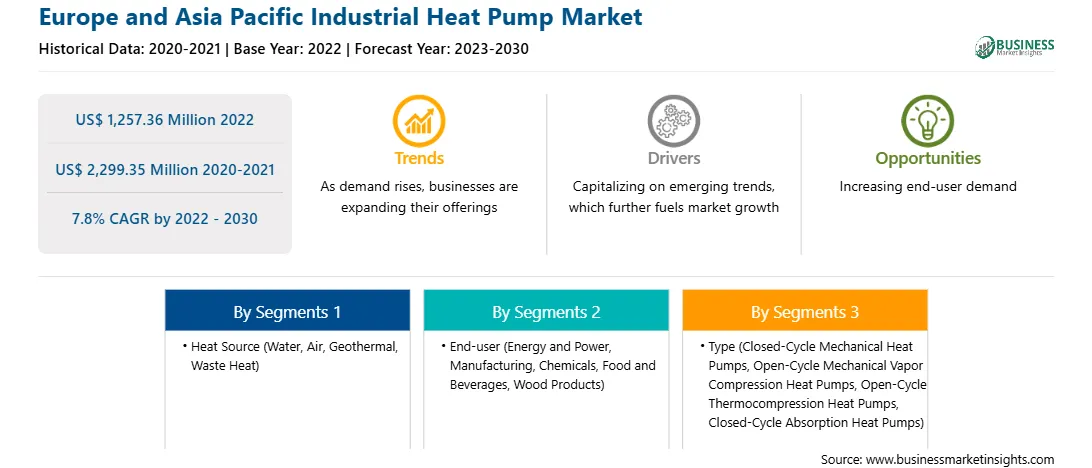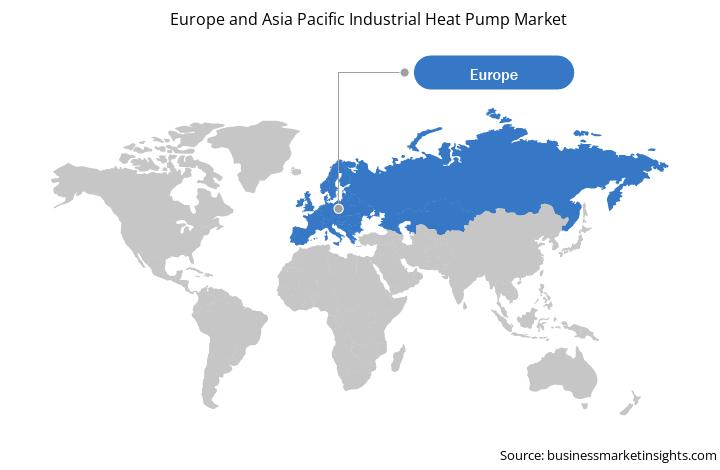Strict regulations and international agreements, such as the Kigali Amendment to the Montreal Protocol, mandate the phasing out of high-GWP refrigerants. Heat pump systems utilizing lower-GWP refrigerants allow industries to comply with these regulations, avoiding penalties and aligning with global efforts to reduce greenhouse gas emissions. Industrial heat pump market players adopting environmentally friendly practices gain a positive public image and enhance brand reputation. Industries that incorporate low-GWP refrigerants in heat pump systems help to enhance their green brand image, which can attract environmentally conscious customers and partners. Industries that adopt heat pump systems with low-GWP refrigerants gain a competitive edge by offering environmentally conscious solutions. This can differentiate them in the industrial heat pump market and attract clients who prioritize sustainability. The emergence of lower global warming potential (GWP) refrigerants is providing significant opportunities for the industrial heat pump market growth due to their alignment with environmental regulations, improved efficiency, and enhanced sustainability.
Industrial heat pumps can efficiently utilize excess renewable energy generated from sources such as solar and wind power. During times of surplus energy production, heat pumps can convert and store this energy in the form of heat, ensuring its utilization even when renewable energy generation is low. This synergy contributes to a more sustainable energy mix. The integration of renewable energy sources with heat pumps helps industries shift away from fossil fuels, reducing greenhouse gas emissions which is boosting to the industrial heat pump market growth. This aligns with global efforts to mitigate climate change and adhere to environmental regulations, making heat pump solutions an attractive option for industries aiming to decarbonize their operations. Renewable energy integration with industrial heat pumps is expected to provide significant market growth opportunities by aligning with sustainability goals, improving energy efficiency, and reducing operational costs for industries, creating a win-win scenario for industries, consumers, and the environment.
Industrial heat pump market is gaining potentially opportunities in energy & power, manufacturing, chemicals, food & beverages, paper & pulp, and wood products industries. Other end-use industries include agricultural, indoor cultivation, textiles, pharmaceuticals, cement, and concrete processing. The increasing focus on lowering environmental pollution and reducing the carbon footprint are major benefits accelerating the demand for industrial heat pumps. Industrial heat pumps can potentially increase energy efficiency and decrease CO2 emissions. Industrial heat pumps offer various opportunities for manufacturing processes and operations. Industrial heat pumps primarily utilize waste process heat as the heat source to deliver heat at higher temperatures for application in industrial processes. Industrial heat pumps are active heat-recovery systems that boost waste heat temperature in an industrial process. An industrial heat pump is larger and has a more advanced capacity than a residential or commercial heat pump and is largely designed for higher operating load factors, discharge temperatures, and consistency. Additional features such as control systems, instrumentation, and power to withstand hazardous environments are also evident, making the industrial heat pumps more attractive in various end-user industries such as chemical processing, paper and pulp, manufacturing, and power which is contributing to the Europe and Asia Pacific industrial heat pump market growth.
A few major primary and secondary sources referred to for preparing the report on the industrial heat pump market are company websites, annual reports, financial reports, national government documents, and statistical databases. The Europe and Asia Pacific industrial heat pump market players in report includes Mitsubishi Heavy Industries, Daikin Industries Ltd, Danfoss A/S, Emerson Electric, Johnson Controls International Plc, Robert Bosch GmbH, Siemens AG, Carrier, Swegon, and Atlas Copco AB. These players are involved in various strategic initiatives such as new product development, partnerships, agreement, and mergers & acquisitions to strengthen their position in Europe and Asia Pacific industrial heat pump market.
Strategic insights for the Europe and Asia Pacific Industrial Heat Pump provides data-driven analysis of the industry landscape, including current trends, key players, and regional nuances. These insights offer actionable recommendations, enabling readers to differentiate themselves from competitors by identifying untapped segments or developing unique value propositions. Leveraging data analytics, these insights help industry players anticipate the market shifts, whether investors, manufacturers, or other stakeholders. A future-oriented perspective is essential, helping stakeholders anticipate market shifts and position themselves for long-term success in this dynamic region. Ultimately, effective strategic insights empower readers to make informed decisions that drive profitability and achieve their business objectives within the market.

| Report Attribute | Details |
|---|---|
| Market size in 2022 | US$ 1,257.36 Million |
| Market Size by 2030 | US$ 2,299.35 Million |
| Global CAGR (2022 - 2030) | 7.8% |
| Historical Data | 2020-2021 |
| Forecast period | 2023-2030 |
| Segments Covered |
By Heat Source
|
| Regions and Countries Covered | Europe
|
| Market leaders and key company profiles |
The geographic scope of the Europe and Asia Pacific Industrial Heat Pump refers to the specific areas in which a business operates and competes. Understanding local distinctions, such as diverse consumer preferences (e.g., demand for specific plug types or battery backup durations), varying economic conditions, and regulatory environments, is crucial for tailoring strategies to specific markets. Businesses can expand their reach by identifying underserved areas or adapting their offerings to meet local demands. A clear market focus allows for more effective resource allocation, targeted marketing campaigns, and better positioning against local competitors, ultimately driving growth in those targeted areas.

The Europe and Asia Pacific Industrial Heat Pump Market is valued at US$ 1,257.36 Million in 2022, it is projected to reach US$ 2,299.35 Million by 2030.
As per our report Europe and Asia Pacific Industrial Heat Pump Market, the market size is valued at US$ 1,257.36 Million in 2022, projecting it to reach US$ 2,299.35 Million by 2030. This translates to a CAGR of approximately 7.8% during the forecast period.
The Europe and Asia Pacific Industrial Heat Pump Market report typically cover these key segments-
The historic period, base year, and forecast period can vary slightly depending on the specific market research report. However, for the Europe and Asia Pacific Industrial Heat Pump Market report:
The Europe and Asia Pacific Industrial Heat Pump Market is populated by several key players, each contributing to its growth and innovation. Some of the major players include:
The Europe and Asia Pacific Industrial Heat Pump Market report is valuable for diverse stakeholders, including:
Essentially, anyone involved in or considering involvement in the Europe and Asia Pacific Industrial Heat Pump Market value chain can benefit from the information contained in a comprehensive market report.